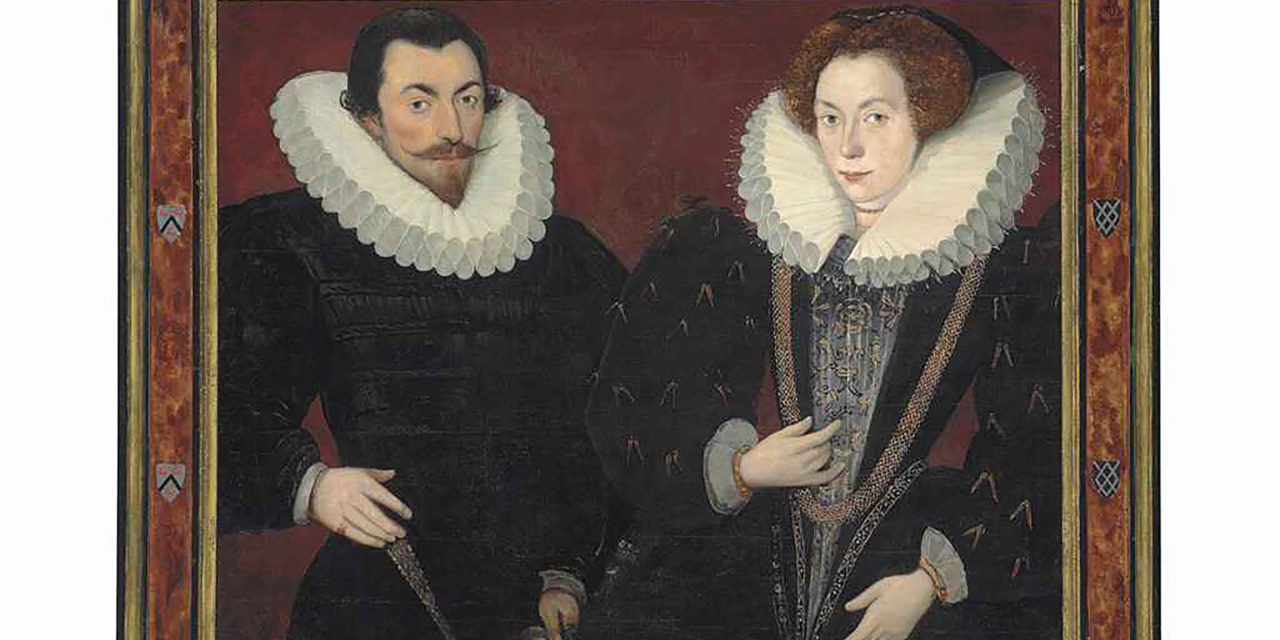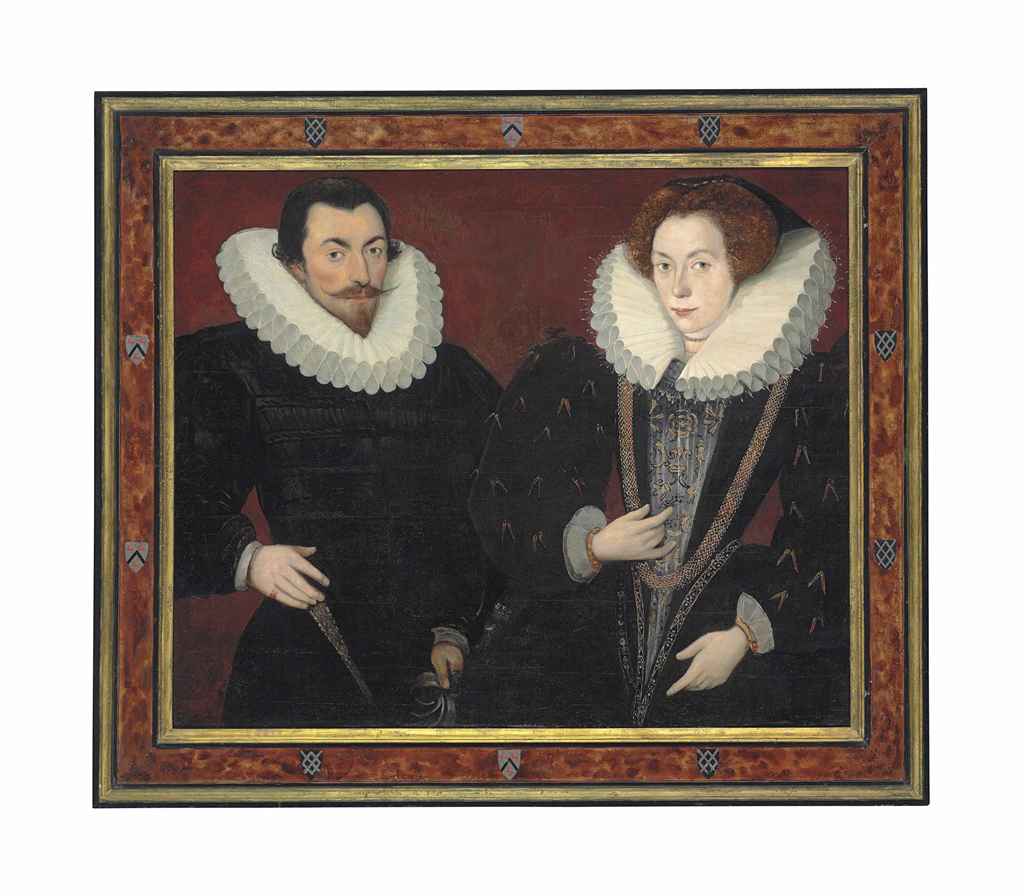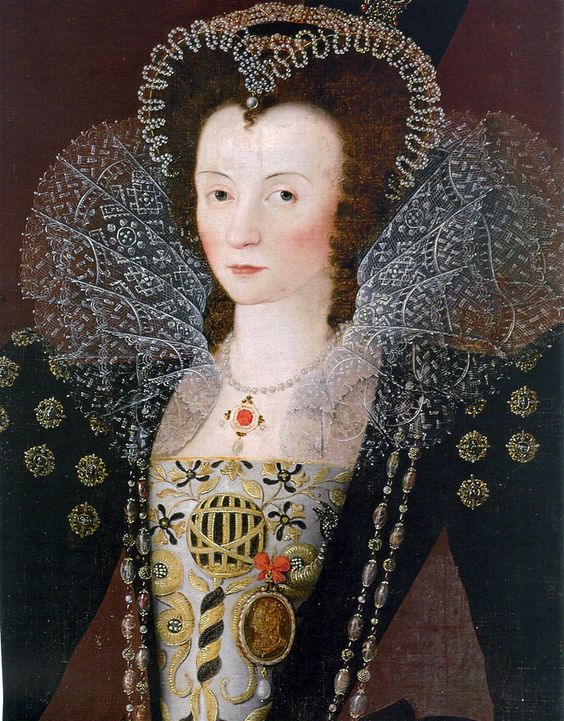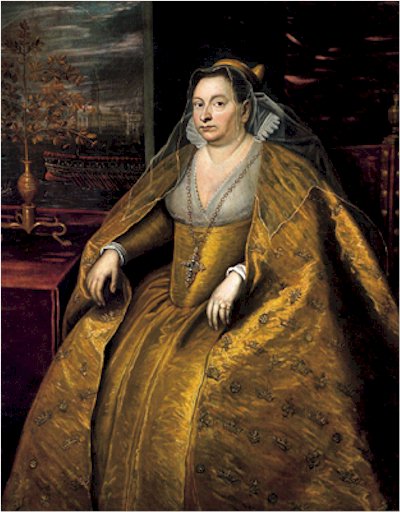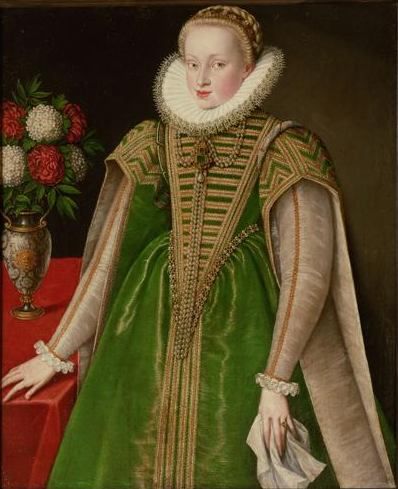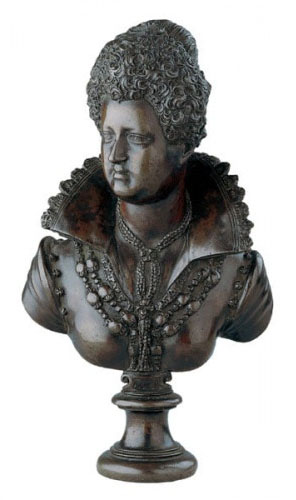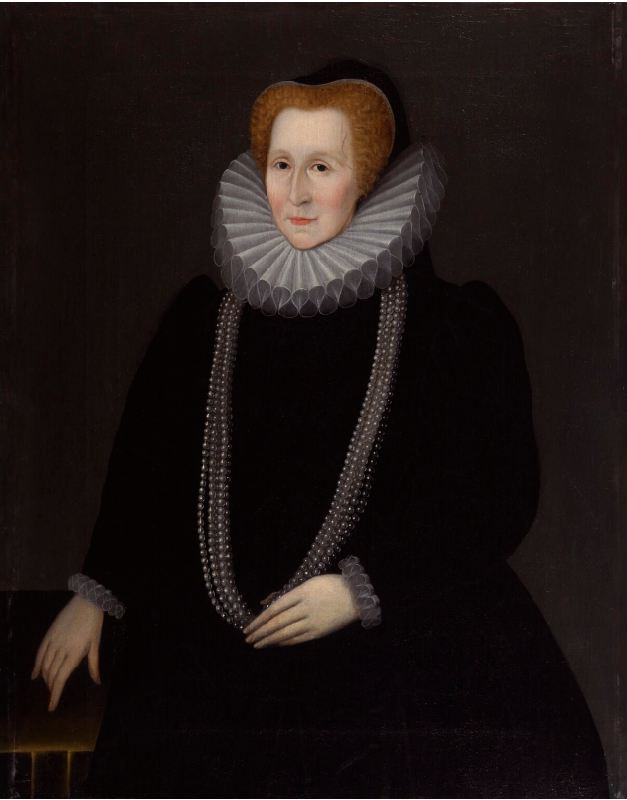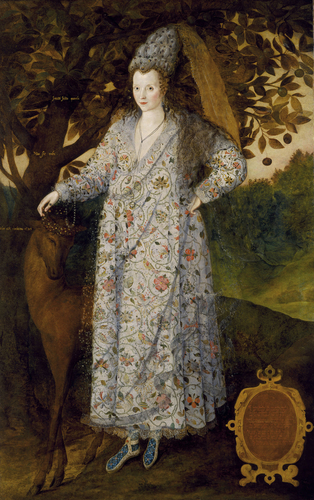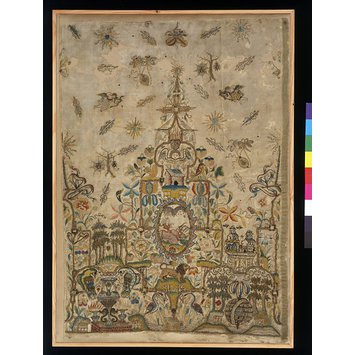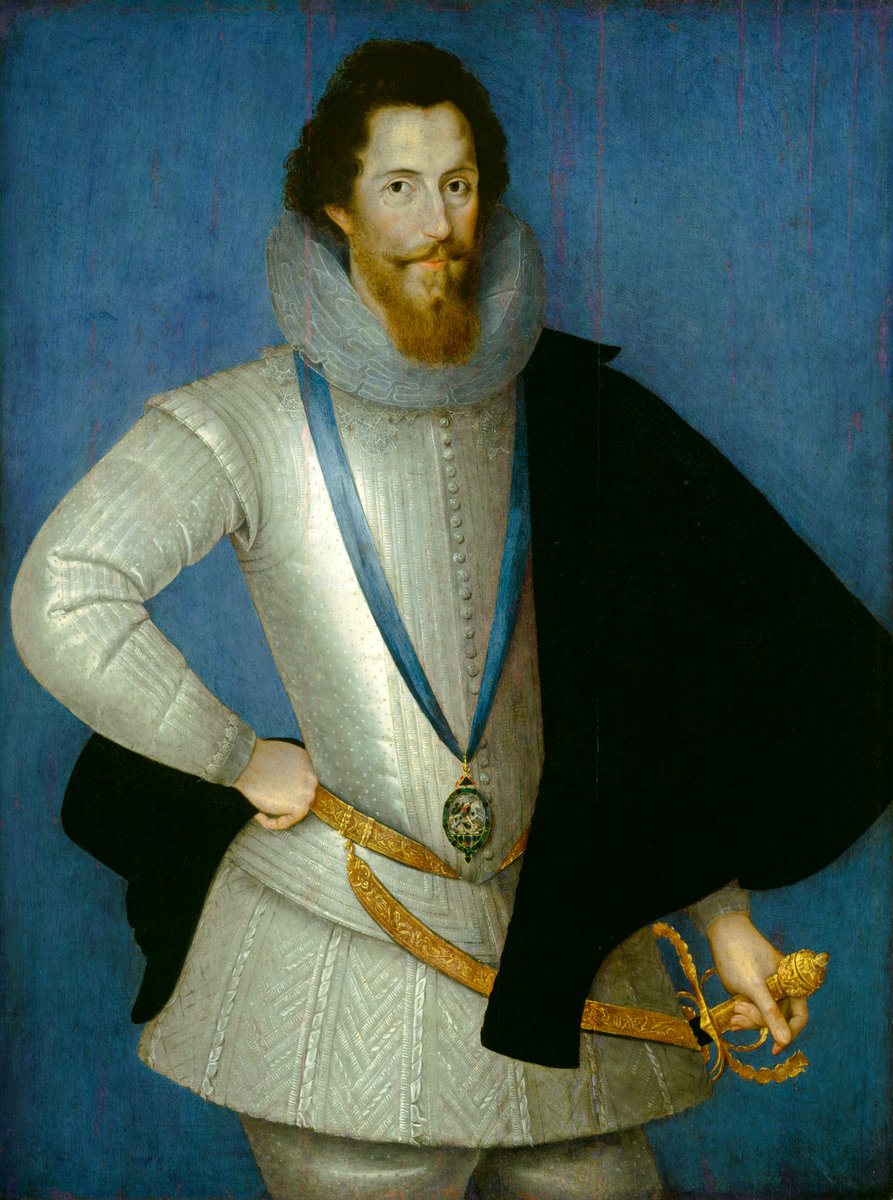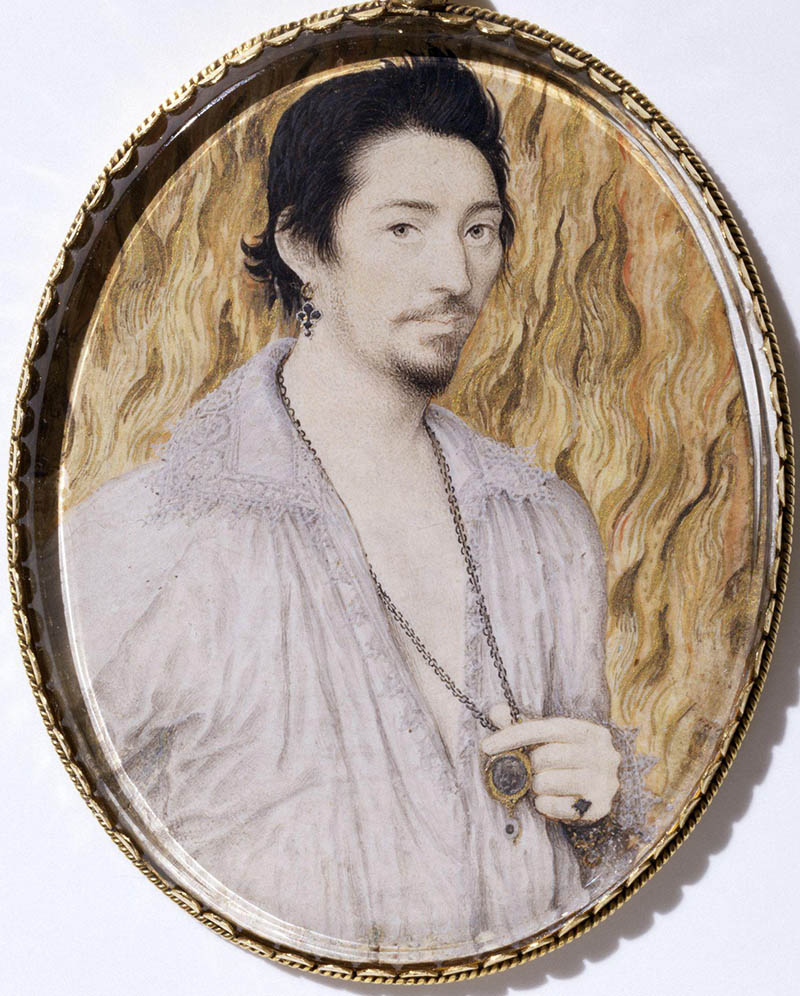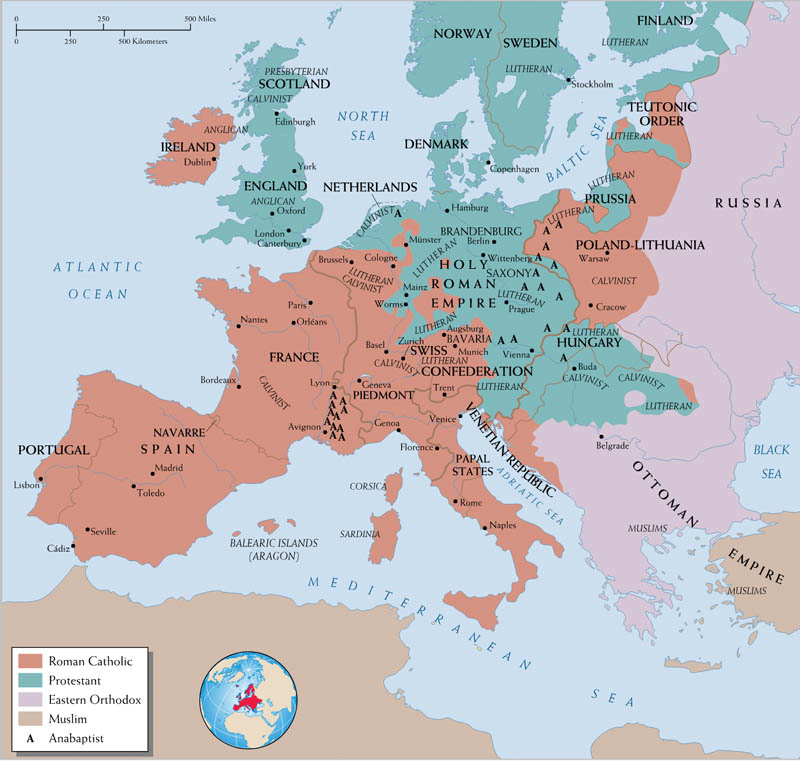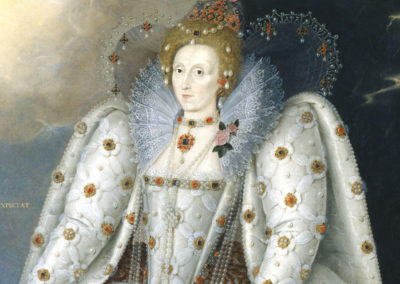OVERVIEW
1590s fashion exaggerated previous styles, with women’s farthingale skirts expanding and men’s hose shrinking further still.
Europe in the 1590s was on the cusp of great change. In the latter half of the decade, a series of treaties finally ended religious warfare that had plagued France, the Low Countries, England, and Spain for decades. In England, an aging, childless queen fanned the anxieties of her councilors and her people, as they wondered who would lead them next. Amongst European powers, like the Netherlands, England, Spain, and Portugal, commercial competition fueled a nascent proto-industrial, globalized economy. As each decade sees its regressions and advancements, glories and unanticipated strife, the sixteenth century came to a close at the front steps of the modern world.
Clothing in the 1590s reflected this stage of both finality and growth. As in the 1580s, pattern books, emblem books, costume books, dress patterns, ambassadors, portrait prints, and diplomatic gifts circulated between European centers, maintaining stylistic dialogues and a regular stock of imported goods. Preferences did not shift towards entirely new trends as much as towards exaggerations of earlier styles (Fig. 1). In England, for example, men’s hose became still shorter, and women’s farthingales, still wider (Fig. 2). Dress maintained its complexity, calling for further ornamentation and elaborate embroidery (Fig. 3).
Clothing was, as ever, central to daily life—and a great concern of moralists. In 1592, a German visitor to England observed,
“The women…go dressed out in exceedingly fine clothes, and give all their attention to their ruffs and stuffs to such a degree indeed, that, as I am informed, many a one does not hesitate to wear velvet in the streets, which is common with them, whilst at home perhaps they have not a piece of dry bread.” (Ashelford 12)
These worries echoed William Harrison’s 1577 Description of England:
“Oh, how much cost is bestowed nowadays upon our bodies and how little upon our souls! How many suits of apparel hath the one, and how little furniture hath the other! How long time is asked in decking up of the first, and how little space left wherein to feed the latter!” (Ashelford 12)
There was a perpetual concern with the men and women who delighted in dressing, or wielded its power. Yet this moralistic, conservative opinion does not necessarily reflect reality. Throughout the 1590s, monarchs and subjects alike continued to cultivate a densely iconographical style, crafting public and private identities to reflect their political, social, and familial obligations and aspirations.
Fig. 1 - Artist unknown. Double portrait of Sir John Harington (1560-1612), of Kelston, and Mary, Lady Harington (c. 1571-1634), 1593. Oil on panel, transferred onto board; 94 x 77.8 cm (30 5/8 x 37 in). Private Collection. Source: Christie's
Fig. 2 - Robert Peake the Elder (English, 1551-1619). Catherine Carey, Countess of Nottingham, 1597. Oil on canvas. London: The Weiss Gallery. Source: Pinterest
Fig. 3 - Marcus Gheeraerts the younger (Flemish, 1561-1636). Dorothy, Lady Dormer, 1596. Oil on canvas. Private Collection. Source: Pinterest
Womenswear
As in menswear, the actual components of a woman’s wardrobe did not drastically change from the decade before. As in the 1580s, a woman’s wardrobe included bodices, wide sleeves shaped with whalebone, stomachers, kirtles, and collars. In Western Europe, skirts and sleeves remained voluminous, while bodices (and their accessories) either reached the neck or revealed significant décolletage. In France, bodices were low cut (Fig. 1)—but not quite as low as in Italy, where they were sometimes cut below the breast, so women relied on the chemise for modesty, as seen in Domenico Robusti’s portrait of the Dogaressa Morosina Morosini (Fig. 2).
These Italian gowns tended to be made from brocades or silks, which were worn in a variety of colors and were sometimes studded with gems (Paulicelli 134). Their luxurious fabrics and the u-shaped curve of the bodice’s bottom appear throughout De gli Habiti antichi et moderni di Diverse Parti del Mondo, a 1590 book of costume engravings. In Spain, however, the bell-shaped farthingale remained popular. There, skirts were paired with shorter bodices and open, sweeping sleeves (Payne 317). A surviving example at The Metropolitan Museum of Art shows the comparatively high neckline, peplum bodice (perhaps inspired by armor), rich metal-wrapped threads, and a typical conical structure of the Spanish silhouette (Fig. 3).
Fashion-forward Englishwomen were, of course, looking to other countries, especially France and Italy for guidance. In England, the 1590s showcased an even wider, more unbalanced silhouette than the decade before. The inverted triangle of the stomacher—inspired by popular French fashions—became longer and narrower, as can be seen in the portrait of Maria Christina, Archduchess of Austria (Fig. 4). This inverted triangle plunged deep into the ever-expanding berth of the French, or wheeled farthingale (Ashelford). Ruffs occasionally multiplied or were layered with wired veils.
French fashions increasingly demanded a stiffened, emanating ruff, which would have been propped up by a supportasse. These additions highlighted elaborate lace patterns as well as laborious preparation. Barthelemy Prieur’s bust of Marie de Medici (Fig. 5), now at the Ashmolean Museum, shows an elongated hairstyle, neck, and ruff curvature coupled with layers of dangling jewels.
Fig. 3 - Designer unknown (Spanish). Ensemble, late 16th century. Silk, linen. New York: The Metropolitan Museum of Art, 25.118a–c. Fletcher Fund, 1925. Source: The Met
Fig. 4 - Artist unknown (Austrian). Maria Christina, Archduchess of Austria, Princess of Transylvania, ca. 1592. Oil on canvas; 110 × 91 cm (43.3 × 35.8 in). Vienna: Kunsthistorisches Museum. Source: KHM
Fig. 5 - Barthelemy Prieur (French, 1536-1611). Bust of Marie de Medici, ca. 1600. Bronze. Oxford: Ashmolean Museum. Source: ArtFund
Fig. 6 - Marcus Gheeraerts the Younger (Flemish, 1561- 1635). Ellen Maurice, 1597. Oil on panel; 90.6 x 74.2 cm (35 5/8 x 29 1/4 in). New York: The Metropolitan Museum of Art, 2017.249. Purchase, Theodocia and Joseph Arkus and University Place Foundation Gifts. Source: The Met
In the Ditchley Portrait of the English Queen Elizabeth I (see Fig. 1 in the “Fashion Icon” section below), we see the queen in white satin, ornamented with silk puffs, jewels, and goldsmith’s work (Norris 606). Her kirtle extends outward—almost horizontally—due to her wheeled farthingale. Her bodice is cut with a square neckline, further ornamented with rubies and pearls that accentuate those on her headdress and veil. In the overabundance of material, she sports hanging sleeves over her elaborately shaped arms. Her ruff is open as to highlight her pale chest against her brilliant necklace. The wired veil—yet another layer—serves as an exclamation point on the sweeping, powerful, structured, sculptural style.
Many courtiers emulated Elizabeth’s lavish, wide attire. Marcus Gheeraerts the Younger also painted Ellen Maurice (Fig. 6) in a similar gown, which lacks only the wired veil and the hanging sleeves–and some of the lavish embellishment of Elizabeth’s gown. Another woman, possibly Lady Arabella Stuart (Fig. 7), mimics Elizabeth’s silhouette, personalizing her look with a stomacher embroidered with flowers and fleur-de-lis in gold. In a miniature by Nicholas Hilliard, Mary Herbert (Fig. 8 wears her own lizard-like ruff, dressed in black and white, the heraldic colors of Queen Elizabeth I. Bess of Hardwick (Fig. 9), on the other hand, pares down the general silhouette popularized by Elizabeth in sober, though still grand, mourning attire appropriate for a middle-aged woman. All three women appear lavish, if by their expensive black dyes, pearls, metal-wrapped threads—or fashionable flora of honeysuckle and roses.
Fig. 7 - Artist unknown. Possibly Lady Arabella Stuart, ca. 1595- 1600. Oil on panel; 18.7 x 13.3 cm (7 3/8 x 5 1/4 in). London: National Portrait Gallery, NPG 1723. Purchased, 1914. Source: NPG
Fig. 8 - Nicholas Hilliard (English, 1547- 1619). Mary Herbert, Countess of Pembroke, ca. 1590. Watercolour on vellum; diameter: 5.4 cm (2 1/8 in). London: National Portrait Gallery, NPG 5994. Accepted in lieu of tax by H.M. Government and allocated to the Gallery, 1988. Source: NPG
Fig. 9 - Artist unknown. Bess of Hardwick, Probably 17th century, based on a work ca. 1590. Oil on canvas; 98.8 x 78.7 cm (38 7/8 x 31 in). London: National Portrait Gallery, NPG 203. Purchased, 1865. Source: NPG
Elaborate, naturalistic embroidery pervaded dress in this period. Marcus Gheeraerts the Younger’s portrait of an unknown woman (Fig. 10) testifies to its popularity. Inspired by the natural world, embroiderers—both amateur and professional—copied elaborate schemes from pattern books and emblem books that featured flowers, insects, and animals. As Reynolds explains in In Fine Style, these floral attributes also held symbolic significance, contributing to elaborate iconographical programs (Reynolds 189).
In the Hardwick Portrait (see Fig. 2 in the “Fashion Icon” section below), Queen Elizabeth sports a forepart with a complex arrangement including sea-monsters, pansies, snakes, birds, and roses. The combination of wide ruff with a low-cut bodice hints at French and Italian influence. Her sleeves and gown can only be described, in modern terms, as being encrusted with diamonds and pearls, furthering the wealth of self-referential symbolism on display. Although it can be tempting to assume otherwise, portraits provide records of actual garments. Surviving petticoat panels, for example attest to the veracity of their seemingly impossible complexity (Fig. 11). Even gloves, an essential accessory, became canvases for dense symbolism, as highly portable, exchangeable, giftable tokens. Simpler floral blackwork designs remained popular as well (Fig. 12). Indeed, black and white color combinations remained quite frequent (Fig. 13) as they were favorite colors of Queen Elizabeth.
Fig. 10 - Marcus Gheeraerts the Younger (Flemish, 1561- 1635). Portrait of an Unknown Woman, ca. 1590-1600. Oil on canvas; 216.2 x 135.5 cm. London: The Royal Collection Trust, RCIN 406024. Recorded in the collection of Queen Anne. Source: Royal Collection Trust
Fig. 11 - Maker unknown (English). Petticoat panel, ca. 1600. Satin embroidered with silk, silver-gilt thread and spangles; 70.5 x 59 cm (29.75 x 20.5 in). London: Victoria and Albert Museum, T.138-1981. Source: V&A
Fig. 12 - Nicholas Hilliard (English, 1547- 1619). An Unknown Woman, aged 26, 1593. Watercolour on vellum stuck onto a playing card; 5.8 x 4.8 cm. London: Victoria and Albert Museum, P.134-1910. Bequeathed by George Salting. Source: V&A
Fig. 13 - Nicholas Hilliard (English, 1547- 1619). Portrait of Lettice Knollys, Countess of Leicester, 1590-1595. Miniature. Private Collection. Source: Wikipedia
Fashion Icon: Elizabeth I, Queen of England (1533-1603)
Fig. 1 - Marcus Gheeraerts the Younger (Flemish, 1561-1635). Queen Elizabeth I ('The Ditchley portrait'), ca. 1592. Oil on canvas; 241.3 x 152.4 cm (95 x 60 in). London: National Portrait Gallery, NPG 2561. Bequeathed by Harold Lee-Dillon, 17th Viscount Dillon, 1932. Source: NPG
Fig. 2 - Workshop of Nicholas Hilliard (Flemish). Elizabeth I of England Hardwick, 1592-1598/9. Oil on canvas; 223.5 x 168.9 cm (88 x 66 1/2 in). London: National Trust, Hardwick Hall, NT 1129128. Hardwick Hall and its contents were accepted by HM Treasury in part payment of death duties and transferred to the National Trust, in 1959. Source: Wikipedia
Fig. 3 - Attributed to Robert Peake the Elder (British, 1551-1619). Procession Portrait of Elizabeth, ca. 1600-1603. Dorset: Sherborne Castle. Source: BeingBess Blogspot
As a general rule, their political influence, the constant manipulation of family ties, and the complexity of political affairs meant that European monarchs held sartorial sway over their subjects. For Queen Elizabeth I, dress was an especially essential conduit for the display of her power, spearheading the “idiosyncratic patterning of clothing and jewellery” so visible in her portraits discussed above (Figs. 1-2; Reynolds 13). As a woman, her right to rule was constantly called into question—dress was a daily tool of manipulation that allowed her best present herself to ambassadors, monarchs, and, perhaps most importantly, to her own subjects.
Some ambassadors’ reports lavish attention on the queen’s dress (even more than they do on political affairs). Andre Hurault-Sieur de Maisse, the French ambassador to Elizabeth’s court, recalled the queen dressed in:
“A dress of silver cloth, white and crimson, or silver ‘gauze’ as they call it. This dress had slashed sleeves lined with red taffeta, and this was girt about with other little sleeves that hung down to the ground…The collar of the robe was very high, and the lining of the inner part all adorned with little pendants of rubies and pearls, very many, but quite small. She had also a chain of rubies and pearls about her neck. On her head she wore a garland of the same material and beneath it a great reddish-coloured wig, with a great number of spangles of gold and silver, and hanging down over her forehead some pearls.” (De Maisse 25-26)
At other moments, they reported the queen’s own perception of her garments, her chameleon-like ability to slip into different attires, according to the tenor of each moment. James Melville, the Scottish ambassador, reported:
“The queen said she had clothes of every sort; which every day thereafter, so long as I was there, she changed. One day she had the English weed, another the French, another the Italian, and so forth. She asked me which of them became her best. I answered, in my judgment, the Italian dress; which answer I found pleased her well, for she delighted to show her golden-coloured hair, wearing a caul and bonnet as they do in Italy.” (Melville viii)
As for her subjects, Queen Elizabeth Going in Procession to Blackfriars in 1600 (Fig. 3) demonstrates Elizabeth’s visual and sartorial centrality at court. For art historian Sir Roy Strong, it emblemized the “Cult of Elizabeth,” because “The Procession Picture unlike her other portraits, places [Elizabeth] in relation to her worshippers. It is an image of her and of her court. In this becomes a visual statement on the Elizabethan state, on order, the order of the body politic which she animates” (Strong 52). The women around Elizabeth mimic and complement—but never surpass—her attire. Men swarm around her, watching her, supporting her.
Or, as a German visitor noted during a procession: “The Queen sitting all alone in her splendid coach appeared like a goddess such as painters are wont to depict.” Even as another coach—“embroidered with gold and silver”—approached, it “did not rival that of the Queen” (Von Klarwill 328).
Menswear
As Anna Reynolds writes in In Fine Style, a core obligation of the courtier “was to reflect the glory of the monarch through splendid attire” (Reynolds 16-17). In England, as Queen Elizabeth I aged through the 1590s, her courtiers emphasized their youth and physique, in homage to the forever ageless, virgin monarch. While her health decayed, her courtiers became emblems of youthful vitality, reflections upon the longevity of her reign (Fig. 1).
The central components of a man’s wardrobe carried over from the 1590s: jerkins, doublets, gowns, hose, breeches, nightgowns, cloaks, buskins, boots, pumps, and bonnets. However, two styles became came to the fore:
The first was an athletic, active style, which accentuated the male silhouette and paid homage to the shared language between armor and civilian fashion. In his cabinet miniature of Sir Anthony Mildmay (Fig. 2), Nicholas Hilliard depicts such a gentleman, half-dressed in his armor. Hilliard’s protagonist, however, appears to be Mildmay’s long, tapering legs, rather than the man himself. Trunk hose, which had been gradually rising, became even shorter in the 1590s, freeing the leg and highlighting muscles. Marcus Gheeraerts the Younger’s portrait of Sir Thomas Lee (Fig. 3) illustrates an even more exaggerated, fantastic romanticization of the chivalric soldier. Dressed as a common foot soldier for political reasons, Lee elevates the costume with elaborate blackwork embroidery and lace. It seems possible that he may have applied white lead and painted blue veins upon his legs (as women did to their décolletage) to provide their unnatural pallor (Reynolds 48). The armor itself reflects the late Elizabethan penchant for tournaments, pageants, and fencing, which facilitated the display of masculinity, education, and mannered refinement.
The second style was a loose, deconstructed look, which implied a sense of melancholy (Ashelford). “The Elizabethan Malady,” was a phenomenon, popularized by the late Elizabethan aristocracy, that venerated sadness as a reflection of thoughtfulness and creativity. Common tropes included pale skin, ruffled silks, dishevelment, discarded gloves, and general expressions of despondency and forlornness. Black and white—the “colors” of Queen Elizabeth I—helped emphasize the look. In a miniature by Nicholas Hilliard (Fig. 4), an unidentified man passionately bares his chest in a low-cut shirt lined with lace. Isaac Oliver’s portrayal of a young man seated beneath a tree (Fig. 5) shows a gentleman more completely dressed in a gold doublet (the blackwork falling band and wrist cuffs match), short black trunk hose, black canions, and lace stockings supported by a garter, peeking out from his boots. Although he wears one glove, the other is discarded beside him, while he crosses his arms.
Fig. 1 - Studio of Marcus Gheeraerts the Younger. Robert Devereux, 2nd Earl of Essex, 1596-1601. Oil on panel; 114.7 x 87.7 cm (45 3/16 x 34 1/2 in). Washington: The National Gallery of Art, 1947.18.1. Gift of Mrs. Henry R. Rea. Source: NGA
Fig. 2 - Nicholas Hilliard (English, 1547- 1619). Portrait of Sir Anthony Mildmay, Knight of Apethorpe, Northants, ca. 1590–93. Watercolor on vellum mounted on card, mounted on wood; 23.3 x 17.4 cm (9 3/16 x 6 7/8 in). The Cleveland Museum of Art, 1926.554. Purchase from the J. H. Wade Fund. Source: CMA
Fig. 3 - Marcus Gheeraerts II (Flemish, 1561-1636). Portrait of Captain Thomas Lee, 1594. Oil on canvas; 230.5 x 150.8 cm. London: Tate, T03028. Purchased with assistance from the Friends of the Tate Gallery, the Art Fund and the Pilgrim Trust 1980. Source: Tate
Fig. 4 - Nicholas Hilliard (English, 1547- 1619). Portrait Miniature, ca. 1600. Watercolour on vellum stuck onto card; 8.5 x 6 cm. London: Victoria and Albert Museum, P.5-1917. Purchased with the assistance of the Murray Bequest. Source: V&A
Fig. 5 - Isaac Oliver (French, 1565- 1617). A Young Man Seated Under a Tree, 1590- 1595. Watercolour on vellum laid on card; 12.4 x 8.9 cm. London: Royal Collection Trust, RCIN 420639. `Mr Correy', by c.1725; Dr Richard Mead; from whom bought by Frederick Prince of Wales, between 1745 and 1751. Source: Royal Collection Trust
CHILDREN’S WEAR
Throughout the sixteenth century, children largely mimicked their parents’ attire, with small adjustments. A portrait of Lady Pope with her children (Fig. 1) depicts Anne—the adult—in emulation of Elizabeth, with her bright red hair, wide, puffed sleeves, and white gown. Anne then passes this emulation to her daughter, who is dressed to artificially replicate the queenly/maternal curves, drapes, and stature. Anne’s sons, Thomas and Henry, have not yet been “breeched” and so wear skirted ensembles, relying on a hilt, sword, bow, and arrow to demonstrate that their current state is but liminal. Gortzius Geldorp’s 1598 Family Portrait (Fig. 2) shows three children dressed in the same flat white ruff and black doublet worn by their father.
Fig. 1 - Marcus Gheeraerts the Younger (Flemish, 1561–1636). Anne, Lady Pope with her children, 1596. Oil on canvas; 203.6 x 121.7 cm (80 1/4 x 47 7/8 in). Washington: National Portrait Gallery, NPG L231. Source: NPG
Fig. 2 - Gortzius Geldorp (Flemish, 1553-1618). Family Portrait, 1598. Oil on canvas. Private Collection. Source: Pinterest
References:
- Ashelford, Jane. A Visual History of Costume: The Sixteenth Century. London: Batsford, 1983. http://www.worldcat.org/oclc/748457696.
- Cunnington, C. Willett, and Phillis Cunnington. Handbook of English Costume in the Sixteenth Century. London: Faber and Faber, 1954. http://www.worldcat.org/oclc/362761.
- De Maisse, André Hurault, G. B Harrison, and Robert Arthur Jones. A Journal of All That Was Accomplished by Monsieur de Maisse, Ambassador in England from King Henry IV. to Queen Elizabeth, Anno Domini 1597. Translated and Edited with an Introduction by G.B. Harrison and R.A. Jones. London: Nonesuch Press, 1931. http://www.worldcat.org/oclc/561085450.
- Frye, Susan. Pens and Needles: Women’s Textualities in Early Modern England. Philadelphia: University of Pennsylvania Press, 2013. http://www.worldcat.org/oclc/876393874.
- Kuchta, David. The Three-Piece Suit and Modern Masculinity: England, 1550-1850. Berkeley: University of California Press, 2002. http://www.worldcat.org/oclc/47023516.
- Lynn, Eleri. Tudor Fashion. New Haven: Yale University Press, 2017. http://www.worldcat.org/oclc/973159773.
- McAloon, Jonathan. “The Mysterious Phenomenon of Male Sadness in Renaissance Art.” Artsy, June 10, 2019. https://www.artsy.net/article/artsy-editorial-sad-boys-renaissance.
- Melville, James, and W. Mackay Mackenzie. Memoirs of His Own Life. The Abbey Classics, 1. Boston: Small, Maynard, 1922. https://catalog.hathitrust.org/Record/007690603.
- Norris, Herbert. Tudor Costume and Fashion. Mineola, NY: Dover Publications, 1997. http://www.worldcat.org/oclc/868967373.
- Paulicelli, Eugenia. Writing Fashion in Early Modern Italy: From Sprezzatura to Satire. New York: Routledge, 2016. http://www.worldcat.org/oclc/957682358.
- Payne, Blanche, Geitel Winakor, and Jane Farrell-Beck. The History of Costume: From Ancient Mesopotamia through the Twentieth Century. 2nd ed. New York: HarperCollins, 1992. http://www.worldcat.org/oclc/659908345.
- Reynolds, Anna. In Fine Style: The Art of Tudor and Stuart Fashion. London: Royal Collection Trust, 2013. http://www.worldcat.org/oclc/824726826.
- Richardson, Catherine. Clothing Culture, 1350-1650. New York: Routledge, 2017. http://www.worldcat.org/oclc/976442537.
- Vincent, Susan J. The Anatomy of Fashion: Dressing the Body from the Renaissance to Today. English ed. Oxford: Berg, 2009. http://www.worldcat.org/oclc/785875294.
- Von Klarwill, Victor, Lupold von Wedel, Hans Jacob Breuning von Buchenbach, and T. H Nash. Queen Elizabeth and Some Foreigners Being a Series of Hitherto Unpublished Letters from the Archives of the Hapsburg Family. London: John Lane, 1928. http://catalog.hathitrust.org/api/volumes/oclc/423844.html.
Historical Context
Wikipedia: 1590-1599
Rulers:
- England: Queen Elizabeth I (1558-1603)
- France: King Henry IV (1589-1610)
- Spain
- King Philip II (1556-1598)
- King Philip III (1598-1621)
Religious Divisions in Europe after the Reformation, 1590. Source: The Norton Anthology of English Literature
Events:
- 1590 – Shakespeare wrote his first play
- 1598 – Boris Godunov seizes the throne of Russia, following the death of his brother-in-law, Tsar Feodor I; the Time of Troubles starts.
- 1598 – The Peace of Vervins ends the war between France and Spain.
- 1599 – The Italian city of Pompeii is rediscovered more than 1,500 years after its burial following the eruption of Mount Vesuvius in 79.
Primary/Period Sources
Resources for Fashion History Research
To discover primary/period sources, explore the categories below.
Have a primary source to suggest? Or a newly digitized periodical/book to announce? Contact us!
Digitized Primary/Period Sources
Secondary Sources
Also see the 16th-century overview page for more research sources… or browse our Zotero library.

